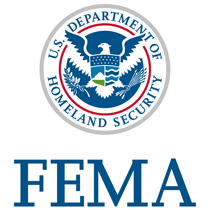Eligibility
Roles & Responsibilities
Program Delivery
Public Assistance begins with the Disaster Declaration Process.
When an area has received a Presidential declaration of an emergency or major disaster, then its state, tribal, territorial and local governments — and certain types of private non-profits — may be eligible to apply for Public Assistance (PA).

Please reference the Public Assistance Program & Policy Guide (PAPPG) for more information on the concepts and terms explained on the page.
Eligibility for Public Assistance Grant Funding
The four basic components of PA eligibility are applicant, facility, work and cost.
- An applicant must be a state, territory, tribe, local government, or certain type of private nonprofit organization.
- A facility must be a building, public works system, equipment, or improved and maintained natural feature.
- Work is categorized as either "emergency" or "permanent." It must be required as a result of the declared incident, located within the designated disaster area, and is the legal responsibility of the eligible Applicant.
- Costs are expenses tied directly to eligible work, and must be adequately documented, authorized, necessary and reasonable. Eligible costs include labor, equipment, materials, contract work, and management costs.

The federal share of assistance is not less than 75 percent of the eligible cost. The Recipient determines how the non-federal share (up to 25 percent) is split with eligible Applicants.
Eligible Types of Work
Emergency Work - Must Be Completed Within Six Months
- Category A: Debris removal
- Category B: Emergency protective measures
Permanent Work - Must Be Completed Within 18 Months
- Category C: Roads and bridges
- Category D: Water control facilities
- Category E: Public buildings and equipment
- Category F: Public utilities
- Category G: Parks, recreational, and other facilities
Roles and Responsibilities
Multiple layers of government work in partnership to administer PA once a disaster has been declared. Each entity must work together to meet the overall objective of a quick, efficient, and effective program delivery.

FEMA: The federal awarding agency authorized to manage the PA program. FEMA's primary responsibilities are to determine the amount of eligible funding, participate in educating the Applicant on specific program issues and procedures, assist the Applicant with the development of project applications and review the projects for compliance with laws, regulations, and policy.
Applicants: Entities submitting a request for assistance under the Recipient's federal award.

Recipients: The State, Territorial, or Tribal government that receives and manages the federal award under the disaster declaration and disburses funding to eligible subrecipients.
Subrecipients: Applicants who have received a subaward from the Recipient and are then bound by the conditions of the award and subaward.
Please note that for simplicity, when describing the process of submitting a project for FEMA PA grant funding FEMA uses the term Applicant when referring to the responsible entity for a project rather than making distinctions between an entity as the Applicant, Recipient, or Subrecipient.
Public Assistance Program Delivery
Program Delivery Guide
The Public Assistance Program Delivery Guide Operational Draft (PA PDG) describes how FEMA implements the PA Program. The PA PDG defines objectives and indicators of success for delivering the program along with Applicant, Recipient, and FEMA roles and responsibilities. It includes an overview of how PA operates and provides detailed information on each phase of the PA project lifecycle.
Program Delivery Model
The PA Program Delivery Model is the process FEMA uses to deliver PA grant assistance to Applicants following a presidential disaster declaration. Projects are categorized based on the type and complexity of Applicant work. Workflows are transparent and accountable online through Grants Manager and Grants Portal. It establishes specialized staff roles and responsibilities, continuously improving processes and technology and centralized grant processing to efficiently and consistently serve Applicants nationwide.
Communities interested in applying for PA should contact their local, state, tribal or territorial emergency manager to begin the process and submit a Request for Public Assistance form. Applicants are highly encouraged to submit their forms through FEMA Grants Portal for faster processing.
Phases of the Public Assistance Delivery Model

Projects must be completed within the Regulatory deadlines. Applicants may submit a request in writing to the Recipient for consideration of a time extension.
Operational Planning and Response Phase
FEMA works with the Recipient to assess Applicant capacity and complexity, as well as impacts and damage, and define operational staffing and resource needs.
Phase 1. Applicant Coordination and Evaluation
FEMA works with the Recipient to engage and educate potential Applicants, prioritizing engagements with Applicants having complex projects or located in underserved communities. As soon as possible following the President’s declaration, the Recipient conducts Applicant briefings, where Applicants receive program orientation and learn about the online grants management system (Grants Portal). Applicants register for PA Grants Portal access and submit Requests for Public Assistance (RPA), which are then reviewed by the Recipient and FEMA for eligibility.
Once an RPA is approved, FEMA assigns the Applicant a Program Delivery Manager (PDMG) or supports the Applicant through the Direct Application process. The PDMG schedules an Exploratory Call and a Recovery Scoping Meeting (RSM) to help the Applicant identify disaster impacts, recovery needs, and provides information about deadlines and next steps.
Phase 2. Impacts and Eligibility
Applicants have 60 days from the Recovery Scoping Meeting to identify and report all disaster-related impacts to FEMA.
FEMA then works with the Applicant to finalize the list of impacts; logically group the impacts and associated damage and work into project applications; conduct site inspections to develop a detailed description of the incident-related damage and dimensions; and collect additional project information and documentation.
Phase 3. Scoping and Costing
FEMA develops the damage description and dimensions (for work completed/fully documented projects only), scopes of work (if not provided by the Applicant), including hazard mitigation proposals, and costs for each project.
FEMA reviews and validates all documentation to ensure document integrity, quality assurance, and compliance with all laws and regulations including for duplication-of-benefits from insurance or other Federal Agencies. Specifically, FEMA Environmental Planning and Historic Preservation (EHP), Hazard Mitigation, and Insurance specialists review information and develop applicable proposals.
Phase 4. Final Reviews
FEMA reviews the project application to ensure completeness, eligibility, and compliance with all applicable laws, regulations, and policies on items such as contracting and EHP.
Once FEMA approves the project, the Recipient reviews the project to ensure the Applicant has properly addressed all incident-related impacts, repair methods, and costs.
The Applicant then reviews the subgrant conditions included in the project application and signs in agreement to the funding terms, including requirements for reporting on project work progress and completion.
Phase 5. Obligation and Recovery Transition
FEMA obligates funds to the Recipient based on the eligible total of an approved project. The Recipient then disburses funding to the Applicant.
Once the Applicant has signed all projects, FEMA coordinates with the Recipient to schedule a Recovery Transition Meeting (RTM). The purpose of the Recovery Transition Meeting is to transition the primary PA point-of-contact from FEMA field personnel to the Recipient.
Phase 6. Post-Award Monitoring and Amendments
The Applicant coordinates with the Recipient to provide FEMA with quarterly updates on the status of its projects.
The Applicant may submit an amendment request to change the scope of work or costs of a project or request additional time to complete the project. FEMA reviews all amendment and time extension requests for eligibility and compliance with EHP regulations.
Phase 7. Final Reconciliation and Closeout
The Applicant coordinates with the Recipient to formally close projects upon completion of work.
Once all Applicant projects are closed, the Recipient requests closeout for the Applicant. Once all Applicants are closed, FEMA and the Recipient work together to close the PA award for the entire disaster.


